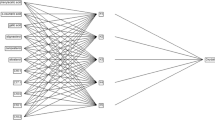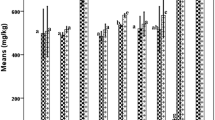Abstract
Refined oils including corn, sunflower, soybean, and palm oils as well as low-quality olive oil such as refined lampante and pomace olive oils are commonly used for extra-virgin olive oil (EVOO) adulteration. Indeed, K 270 could be used as a parameter for the detection of EVOO fraud for each type of the studied refined oils, 10 % olive, 4 % pomace olive, 10 % palm, 5 % corn, and 2 % soybean oils. Moreover, the adulteration could also be detected by the increase of the trans fatty acid contents with 10 % pomace olive, 3 % soybean, 3 % sunflower, 2 % corn, and 10 % palm oils. Actually, stigmasta-3,5-diene content is one of the most effective means of detecting refined oils in EVOO at low levels: 2 % olive, 0.4 % pomace olive, 1 % palm, 0.2 % soybean, 0.5 % sunflower, and 0.1 % corn oils. Finally, the application of linear discriminant analysis could represent an alternative and innovative tool for faster and cheaper evaluation of EVOO adulteration.


Similar content being viewed by others
Abbreviations
- EVOO:
-
Extra-virgin olive oil
- ROO:
-
Refined olive oil
- RPOO:
-
Refined pomace olive oil
- RSbO:
-
Refined soybean oil
- RSfO:
-
Refined sunflower oil
- RPmO:
-
Refined palm oil
- RCoO:
-
Refined corn oil
- TFAs:
-
Trans fatty acids
- GC:
-
Gas chromatography
- GC-MS:
-
Gas chromatography-mass spectrometry
- IOOC:
-
International Olive Oil Council
- LDA:
-
Linear discriminant analysis
- PV:
-
Peroxide value
References
Ackman RG, Mag TK (1998) Trans fatty acids and the potential for less in technical products. In: Sebedio JL, Christie WW (eds) Trans fatty acids in human nutrition. The Oily Press, Dundee, pp 35–58
Ammar S, Zribi A, Mansour AB, Ayadi M, Abdelhedi R, Bouaziz M (2014a) Effect of processing systems on the quality and stability of Chemlali olive oils. J Oleo Sci 63:311–323
Ammar S, Zribi A, Gargouri B, Flamini G, Bouaziz M (2014b) Effect of addition of olive leaves before fruits extraction process to some monovarietal Tunisian extra-virgin olive oils using chemometric analysis. J Agric Food Chem 62:251–263
Aparicio R (2003) Manual del aceite de oliva. In: Aparicio R, HARWOOD J (eds) Autentificación del aceite de oliva, 14th edn. Mundi-prensa, Madri, pp 475–496
Boskou D (1996) Olive oil: chemistry and technology. AOCS Press, Champaign, pp 85–127
Ceriani R, Meirelles AJA (2007) Formation of trans PUFA during deodorization of canola oil: a study through computational simulation. Chem Eng Process 46:375–385
Cert A, Lanzon A, Carelli A, Albi T (1994) Formation of stigmasta-3,5-diene in vegetable oils. Food Chem 49:287–293
Cooperative work of the German Society for Fat Science (DGF) (2001) Bleaching of edible fats and oils. Eur J Lipid Sci Technol 103:505–508
Crews C, Pye C, Macarthur R (2014) An improved rapid stigmastadiene test to detect addition of refined oil to extra virgin olive oil. Food Res Int 60:117–122
Gargouri B, Ammar S, Zribi A, Mansour AB, Bouaziz M (2013) Effect of growing region on quality characteristics and phenolic compounds of chemlali extra-virgin olive oils. Acta Physiol Plant 35:2801–2812
Gargouri B, Zribi A, Bouaziz M (2015) Effect of containers on the quality of Chemlali olive oil during storage. J Food Sci Technol 52:1948–1959
Gomes T, Delcuratolo D, Paradiso VM, Nasti R (2008) Influence of triglyceride oxidation and polymerization compounds on oxidative stability in edible vegetable oils. In: Porretta S (ed) Ricerche e innovazioni nell’industria alimentare. Chiriotti Editore, Pinerolo, pp 509–513
Gordon MH, Firman C (2001) Effects of heating and bleaching on formation of stigmastadienes in olive oil. J Sci Food Agric 81:1530–1532
Guzmán E, Baeten V, Fernández Pierna JA, García-Mesa JA (2011) Application of low-resolution Raman spectroscopy for the analysis of oxidized olive oil. Food Control 22:2036–2040
Homberg E, Bielefeld B (1989) Einfluß von Minorbestandteilen des Unverseifbaren auf die Sterinanalyse. Eur J Lipid Sci Technol 91:105–108
Hou JC, Wang F, Wang YT, Xu J, Zhang CW (2012) Assessment of trans fatty acids in edible oils in China. Food Control 25:211–215
International Norm (2001) Animal and vegetable fats and oils, determination of peroxide value, ISO 3690, 3rd Ed
International Norm (2009) Animal and vegetable fats and oils, determination of acid value and acidity, ISO 660, 3rd Ed
International Olive Oil Council (IOOC) (2001a) COI/T, 20/Doc. No. 24. Preparation of the fatty acid methyl esters from olive oil and olive pomace oil
International Olive Oil Council (IOOC) (2001b) COI/T, 20/Doc. No. 17 Rev. 1. Determination of trans unsaturated fatty acids by capillary column gas chromatography
International Olive Oil Council (IOOC) (2001c) COI/T, 20/ Doc. No. 11. Determination of stigmastadienes in vegetable oils
International Olive Oil Council (IOOC) (2001d) COI/T, 20/ Doc. No. 16 Rev. 1. Determination of sterenes in refined vegetable oils
International Olive Oil Council (IOOC) (2010) COI/T, 20/Doc. No. 19 Rev. 3. Spectrophotometric investigation in the ultraviolet
International Olive Oil Council (IOOC) (2013) COI/T, 15/NC No. 3/Rev. 7. Trade standard applying to olive oils and olive-pomace oils
Jabeur H, Zribi A, Makni J, Rebai A, Abdelhedi R, Bouaziz M (2014) Detection of Chemlali extra-virgin olive oil adulteration mixed with soybean oil, corn oil, and sunflower oil by using GC and HPLC. J Agric Food Chem 62:4893–4904
Jabeur H, Zribi A, Abdelhedi R, Bouaziz M (2015) Effect of olive storage conditions on Chemlali olive oil quality and the effective role of fatty acids alkyl esters in checking olive oils authenticity. Food Chem 169:289–296
Jafari M, Kadivar M, Keramat J (2009) Detection of adulteration in Iranien olive oil using instrumental (CG, NMR, DSC) methods. J Am Oil Chem Soc 86:103–110
Jahouach W, Essid K, Trabelsi M, Frikha MH (2006) Alteration of chemical composition and the oxidative stability of bleached pomace-olive oil on activated clays. J Agric Food Chem 54:7137–7143
Kaynak G, Ersoz M, Kara H (2004) Investigation of the properties of oil at the bleaching unit of an oil refinery. J Colloid Interface Sci 280:131–138
Kim SK, Nawar WW (1991) Oxidative interactions of cholesterol with triacylglycerols. J Am Oil Chem Soc 68:931–934
Kiritsakis A, Kanavouras A, Kiritsakis K (2002) Chemical analysis, quality control and packaging issues of olive oil. Eur J Lipid Sci Technol 104:628–638
Korver O, Zevenbergen JL (1997) Nutritional consequences of oil refining processes' in Oil refining and nutrition. pp 3 − 6
León-Camacho M, Serrano MA, Constante EG (2004) Formation of stigmasta-3,5-diene in olive oil during deodorization and/or physical refining using nitrogen as stripping gas. Grasas Aceites 55:227–232
Longobardi F, Ventrella A, Napoli C, Humpfer E, Schütz B, Schäfer H, Kontominas MG, Sacco A (2012) Classification of olive oils according to geographical origin by using 1H NMR fingerprinting combined with multivariate analysis. Food Chem 130:177–183
Mendes TO, da Rocha RA, Porto BLS, de Oliveira MAL, dos Anjos VDC, Bell MJV (2015) Quantification of extra-virgin olive oil adulteration with soybean oil: a comparative study of NIR, MIR, and raman spectroscopy associated with chemometric approaches. Food Anal Method. doi:10.1007/s12161-015-0121-y
Morchio G, Di Bello A, Mariani C, Fedeli E (1989) Individuazione di particolari oli rettificati in oli vergini di oliva. Riv Ital Sostanze Grasse 66:251–257
Owen RW, Giacosa A, Hull WE, Haubner R, Spiegelhalder B, Bartsch H (2000) The antioxidant/anticancer potential of phenolic compounds isolated from olive oil. Eur J Cancer 36:1235–1247
Piironen V, Lindsay DG, Miettinen TA, Toivo J, Lampi AM (2000) Plant sterols: biosynthesis, biological function and their importance to human nutrition. J Sci Food Agric 80:939–966
Vasvazova PI, Tontchev DT, Totova PF, Nenkova TP (1998) Traitement thermique des acides gras du type linoleique avec de la bentonite. Ol Corps Gras Lipides 5:233–236
Young FVK (1994) In The Lipid Handbook, 2nd edition, (Gun-stone, F.D. Harwood, J.L., Padley, F., eds) Ch 5.4. Chapman and Hall, London, UK
Zribi A, Gargouri B, Jabeur H, Rebaï A, Abdelhedi R, Bouaziz M (2013) Enrichment of pan-frying refined oils with olive leaf phenolic-rich extract to extend the usage life. Eur J Lipid Sci Technol 115:1443–1453
Zribi A, Jabeur H, Aladedunye F, Rebai A, Matthäus B, Bouaziz M (2014) Monitoring of quality and stability characteristics and fatty acid compositions of refined olive and seed oils during repeated pan- and deep-frying using GC, FT-NIRS and chemometrics. J Agric Food Chem 62:10357–10367
Zschau W (2001) Bleaching of edible fats and oils IX. Legal and analytical aspects of bleaching from the working group “technologies of industrial extraction and processing of edible fats”. Eur J Lipid Sci Technol 103:117–122
Acknowledgments
The authors would like to acknowledge the support of the Ministère de l’Enseignement Supérieur et de la Recherche Scientifique and the Ministère de l’Agriculture (ONH Laboratory-Sfax), Tunisia, to this research work.
Conflict of Interest
The authors declare no conflict of interest. Hazem Jabeur declares no conflict of interest. Akram Zribi declares no conflict of interest. Prof. Mohamed Bouaziz declares no conflict of interest.
Compliance with Ethical Standards
This article does not contain any studies with human or animal subjects.
Author information
Authors and Affiliations
Corresponding author
Rights and permissions
About this article
Cite this article
Jabeur, H., Zribi, A. & Bouaziz, M. Extra-Virgin Olive Oil and Cheap Vegetable Oils: Distinction and Detection of Adulteration as Determined by GC and Chemometrics. Food Anal. Methods 9, 712–723 (2016). https://doi.org/10.1007/s12161-015-0249-9
Received:
Accepted:
Published:
Issue Date:
DOI: https://doi.org/10.1007/s12161-015-0249-9




